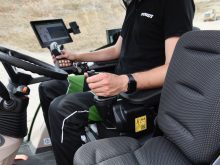Improved operator interface makes tractor and implement control easier
Among the key trends influencing machinery design across all brands today is operator comfort. As part of that, making digital control and access simpler and more intuitive has figured high for engineering priorities as well. AGCO’s Fendt brand has been working on those priorities too. The latest result of that effort is the introduction of the FendtONE operator interface, which debuted on the 700 Gen6 series tractors. It will soon appear on 300 series models, also new to North America.
AGCO’s announcement introducing the FendtONE concept describes it as a “complete redesign of the operator station, providing a streamlined and highly efficient work environment.”
Read Also

Claas brings 1000 Series SP forage harvesters to Canada
In mid-August, Claas unveiled its new line of Jaguar forage harvesters at an event in Visalia, California, deep in the heart of that state’s dairy region.
What’s new: Fendt introduces the FendtONE operator interface — a complete redesign for a highly efficient workspace on 700 series models and, soon, the 300 series tractors.
To start with, the new interface includes up to three LED touch screen displays, which the brand claims are intuitive to use with simple navigation paths that rely on a two-level menu. There is a 12-inch monitor on the reconfigured armrest. The second screen is a 12-inch pull-down display recessed into the roof liner. The third is a 10-inch “digital dashboard,” mounted to the steering column. All three displays are linked and synchronized, providing data in unison. They allow the operator to view up to 12 selected information panels across the two, 12-inch displays, which should be more than enough for most field operations.
The control armrest uses customizable buttons with tractor, hitch and implement controls centrally located to allow operators to more easily make changes and provide input. Alternatively, those control functions can be handled through the multi-function joystick.
Aside from simply improving the ergonomics, the idea behind reconfiguring controls to the most convenient positions is the operator can avoid having to divert his or her attention from driving.
The push-button controls on the armrest are colour-coded and match what appears for that function on the display screen to make finding the correct button easier, which also minimizes the risk of confusing controls. And each one is lit up by a colour-matched LED light. A green light indicates the button function is activated. Unassigned buttons remain unlit. And the number of programmable control buttons has been increased to 11 to accommodate nearly any implement control need.
















